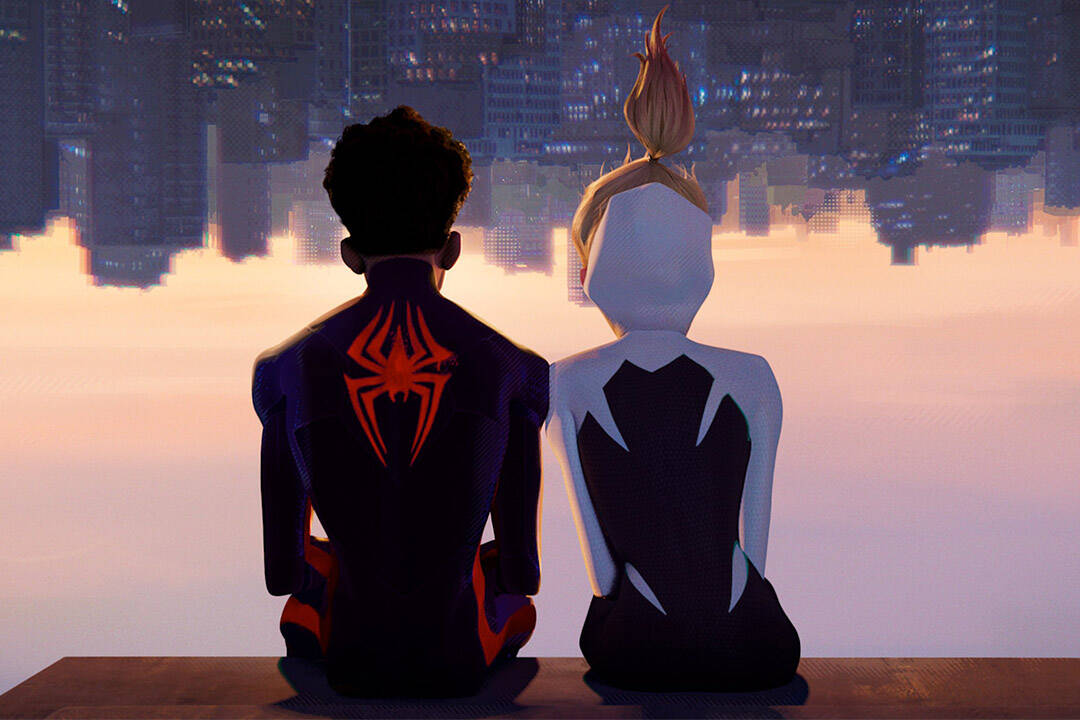In 2018, “Spider-Man: Into the Spider-Verse” was a revelation. Its impact and influence is actively being felt across the western animation landscape. “Spider-Man: Across the Spider-Verse,” which was released last week, nearly five years later, somehow earns a place in that same conversation — in many ways it raises the bar even higher.
“Across the Spider-Verse” is a more ambitious film than its predecessor. It takes more swings — wilder swings. It features five settings with entirely distinct art styles, then juxtaposes those styles against one another and throws even more into the mix.
It’s an absolutely flooring technical showcase, experimenting even with the frame rate of individual characters in ways truly innovative. It’s a deeply emotional and personal story about identity and community. Like the first film, it’s also a commentary on comic book culture filled with barbs and references to Spider-Man’s more than 60-year history.
At the center of it all is Shameik Moore’s Miles Morales, New York’s one and only Spider-Man, who returns with his vibrant, comic book-styled take on Brooklyn.
Also returning is Hailee Steinfeld’s Gwen Stacy, the Spider-Woman of another universe, every bit the main character in this entry that Miles is. Her world is realized with a watercolor aesthetic, details subdued. The colors around her shift to match the emotions of each scene. Beyond the visuals, she has her own identity in the score, defined by a synth-rock beat and a wistful six-note arpeggio.
Her treatment isn’t unique. Oscar Issac’s Miguel O’Hara, Spider-Man 2099, also has his own musical theme, haunting sound cue and art style. So do standout new additions in Karan Soni’s Pavitr Prabhakar, Spider-Man India, and Daniel Kaluuya’s Hobie Brown, Spider-Punk — who is easily the most outrageously realized as an anarchist who looks like he walked out of a print punk-rock poster.
Each of these characters is allowed to keep their identity even as they stand side by side, making for a film that looks radically different moment by moment. Scenes set in Miles’ Brooklyn, Miguel’s cyberpunk-infused Nueva York and Pavitr’s India-inspired Mumbattan each look like they could come from different films.
It’s heartening to see that “Across the Spider-Verse” is unapologetic in its inclusivity, in a way that feels truly refreshing when so many big budget films still feel behind the curve in telling stories with diverse casts.
The last “Spider-Man” film, 2021’s “Spider-Man: No Way Home,” similarly a multiverse story, starred three white men as its heroes. “Across the Spider-Verse” is led by an immediately more representative cast of heroes in terms of race, culture, gender, sexual orientation and ability. The movie explicitly says “protect trans kids” and “Black Lives Matter” — that’s not subtext. That shouldn’t feel groundbreaking.
In my experience, multiversal stories are fun. They make for audience-pleasing cameos; they rarely make for great storytelling. In the years, months and days before this film dropped, I was nervous about “Across the Spider-Verse,” certainly a film that would be fun to look at, less clearly a narrative masterpiece. I needn’t have been.
Through Miles and Gwen, we see two misfits, profoundly lonely despite being surrounded by others, desperate to be part of something. A year after they teamed up together with a gang of Spider-People to stop the Kingpin in Miles’ universe, they’re stuck dealing with their own problems — unable to turn to anyone for help. They “haven’t found the right band.”
Multiversal shenanigans put the two back together, and later into the Spider Society, a secret spider-versal spider-cop organization led by Miguel that serves to correct “anomalies” and protect “the canon” with an uncompromising hand. Our young and idealistic superheroes quickly find themselves less than convinced with the Spider Society’s methods and mission.
It’s that idea of canon, the idea that each Spider-Person, each individual, should follow the same story and face the same hardship, that the film directly says is bad in an assault on both comic book culture and generational trauma.
At the heart of the film is Miles’ relationships with Gwen and with his parents. For every thrilling, wonderfully animated action scene is a quieter moment between Miles and Gwen, or Miles and Luna Lauren Vélez’s Rio Morales, or Miles and Brian Tyree Henry’s Jefferson Davis.
“Across the Spider-Verse” ends with its main conflict entirely unresolved — it’s a Part One in a truer sense than we often get these days. For that reason, it’s the conversations between Miles and others — specifically his mother — that represent the film’s real — and satisfying — arc.
“Wherever you go from here, you have to promise to look out for that little boy for me,” Rio says to her son. “Make sure he never forgets where he came from, and he never doubts that he is loved, and he never lets anyone tell him that he doesn’t belong there.”
Instead of a flashy final battle between Miles and real villain The Spot, the film’s third act hinges on these conversations — Miles and his mother, Gwen and her father. Its narrative threads are resolved with subtle conversations.
The film tackles individuality and identity, ambition, hope, loneliness and community with a deft hand — defter, perhaps, than a film where Spider-Man is chased by hundreds of other Spider-People should be.
“Spider-Man: Across the Spider-Verse” is a knockout, a unique technical achievement and a groundbreaking film for both mainstream animation and for comic book cinema. I know people who turn up their nose at it and its predecessor because it looks “weird.” It is — it’s unlike anything else in theaters. It shouldn’t be missed.
“Spider-Man: Across the Spider-Verse” is playing this weekend at Kenai Cinema and the Orca Theater. Check showtimes and get tickets at catheaters.com and orcatheater.com.

